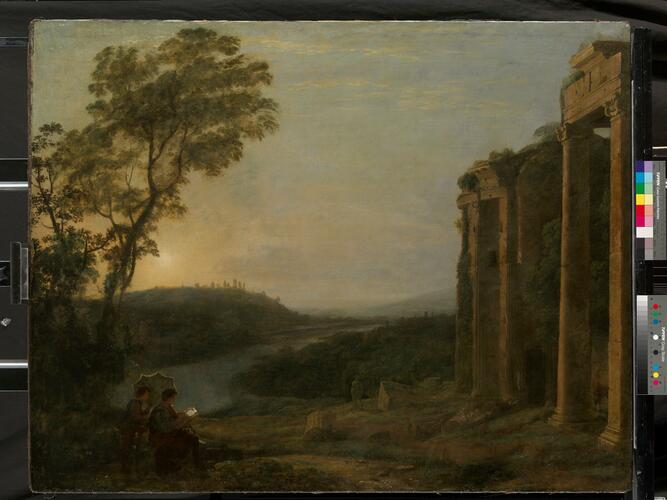A Landscape with Ruins c. 1630
Oil on canvas | 97.7 x 124.7 cm (whole object) | RCIN 404690
-
An artist sits sketching the classical ruins ahead of him, while an assistant holds a parasol to shield him from the low sun on the horizon. This painting was engraved in 1769 as The Morning after Claude Gellée, called Le Lorrain, although discoloured pigments in the sky have probably reduced the subtlety of the original light effects that may have indicated the time of day. Claude was particularly interested in capturing the variable effects of light on the landscape and was one of the earliest artists to sketch outdoors. Joachim von Sandrart met the artist in 1628 and wrote that ‘Poussin, Claude Lorrain and I rode to Tivoli to paint or draw landscapes from life’. In Claude’s paintings architectural features from different locations are often combined within one idealised composition – here the circular temple is based on the Temple of the Sibyl at Tivoli, while the other recalls the Temple of Saturn at the foot of the Capitoline Hill.
Several of Claude’s paintings of the 1630s include draughtsmen of the type seen here, although in this example the artist holds a red chalk porte-crayon, whereas Claude tended to work outdoors in pen and ink. Sandrart also reports that Claude made oil sketches on canvas in the open air, although these have remained elusive. The motif of an artist sketching outdoors became popular for landscape painters working in Rome during the middle decades of the seventeenth century and continued into the eighteenth. Other examples in the Royal Collection include Canaletto’s Rome: The Arch of Constantine (RCIN 400713) of 1742 and Antonio Visentini’s Capriccio with a view of Mereworth Castle, Kent (RCIN 400687) of 1746.
Heavily discoloured varnish and restoration overpaint have made it difficult to determine the quality and authorship of this picture, although recent conservation has revealed that the pigments used (which include much-faded smalt in the sky and ultramarine blue in the figures) together with the coarse, open-weave canvas are both consistent with Claude’s working practice in Italy during the seventeenth century. The quality is variable across the picture surface – while the architectural elements are carefully observed, the figures are more crudely painted and may have been added later. If the painting is by Claude, then it must be an early work, since it is not recorded in his Liber Veritatis, which he began around 1635.
The painting appears in Pyne's illustrated Royal Residences of 1819, hanging in the Blue Velvet Room at Buckingham Palace (RCIN 922144).
Text adapted from Portrait of the Artist, London, 2016Provenance
First recorded in the collection of Frederick, Prince of Wales at Leicester House, 1749.
-
Creator(s)
(nationality)Acquirer(s)
-
Medium and techniques
Oil on canvas
Measurements
97.7 x 124.7 cm (whole object)
131.0 x 160.3 x 15.0 cm (frame, external)
Category
Object type(s)
Subject(s)









